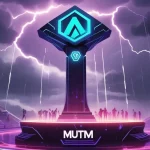XRP Tundra: 2025’s Hottest Crypto Bet or Just Another Hyped Altcoin?

XRP Tundra: 2025’s Crypto Contender or Overhyped Gamble?
A new name is making waves in the crypto sphere as we gear up for what could be a transformative 2025. XRP Tundra, a project promising to revolutionize decentralized finance (DeFi) on the XRP Ledger with a dual-chain model and institutional muscle, is turning heads among analysts as a top investment pick. But beneath the buzz, is this a genuine game-changer or just another altcoin riding the hype wave? For deeper insights into why this project is gaining traction, check out this detailed analysis on top cryptos for 2025.
- Institutional Push: A major entity acquired XRP Tundra, speeding its launch to December 15, 2025, with a presale price of just $0.01.
- Dual-Chain Design: Leverages XRP Ledger for governance and Solana for high-speed staking, with a Layer 2 unification via GlacierChain planned for 2026–2027.
- Economic Backbone: Offers staking returns tied to real protocol revenue, not inflation, with a hard-capped token supply for scarcity.
What Exactly Is XRP Tundra?
XRP Tundra isn’t your run-of-the-mill altcoin churned out for a quick profit. It positions itself as a critical DeFi layer for the XRP Ledger (XRPL), a blockchain renowned for near-instant settlements and dirt-cheap fees but historically light on robust DeFi tools. For the uninitiated, DeFi refers to financial applications built on blockchain technology, aiming to cut out middlemen like banks with decentralized alternatives for lending, borrowing, or trading. XRPL’s potential in this space has been untapped, and Tundra wants to fill that gap.
The project operates on a dual-chain model, splitting its functions for maximum efficiency. TUNDRA-X runs on XRPL, handling governance—think decision-making and reserve management—while TUNDRA-S operates on Solana, a blockchain known for its scalability, to manage high-throughput staking and transactions. Picture it like a company with two branches: one focused on strategy and the other on day-to-day operations. The goal? Harness the strengths of both chains while sidestepping their individual weaknesses. Down the line, the team plans GlacierChain, a Layer 2 solution (a secondary framework on top of a blockchain to boost speed and cut costs) set for 2026–2027, to merge these systems into one seamless revenue and governance hub. Bold vision, no doubt—but in crypto, ambitious roadmaps are often easier drawn than driven.
Pricing Hype: A Bargain or a Trap?
Let’s cut to the chase: price often drowns out tech talk in crypto circles, and XRP Tundra’s numbers are raising eyebrows. Its presale is fixed at a measly $0.01 per token—cheaper than a vending machine snack. Post-launch, TUNDRA-S will hit the market at $2.50 and TUNDRA-X at $1.25, a staggering 100x-plus jump from the initial entry point. That kind of differential screams potential for outsized gains, especially for early birds jumping on 2025 crypto trends. Add to that an institutional acquisition—a major player buying in, fast-tracking the launch to December 15, 2025—and you’ve got a setup that looks legit on paper.
But hold your horses. Crypto is a minefield of broken promises, where low entry prices often lure suckers into projects that crash harder than a house of cards. While the fixed presale and institutional backing add credibility rare in speculative XRP DeFi projects, nothing is guaranteed. Market swings, adoption hurdles, or even a botched launch could turn this bargain into a bust. If you’re a small-time holder eyeing the next big thing, that $0.01 price tag might tempt you—but remember, cheap can still mean costly if the project flops.
Economic Model: Revenue Over Hype
Unlike countless tokens where staking rewards are just a fancy way to print more coins and dilute value, XRP Tundra ties its returns to actual ecosystem activity. Staking—locking up tokens to support the network and earn rewards—pays out from protocol fees (think charges for swaps or lending), sales of Frost Key NFTs (unique digital assets linked to the platform), and treasury growth via TUNDRA-X accumulation. A hard-capped supply means there’s a strict limit on tokens ever created, baking in scarcity if demand kicks off. No sneaky inflation here, which is a breath of fresh air in a space littered with endless minting schemes.
Yet, pretty whitepapers don’t equal real-world wins. Revenue-backed staking sounds solid, but it hinges on user adoption. If no one’s swapping, lending, or buying NFTs on Tundra’s platform, those returns could dry up faster than a desert puddle. For all its economic finesse, this Solana staking protocol wannabe needs to prove it can draw a crowd—a challenge even established projects struggle with.
Security: Trust in a Trustless World
In a space where hacks and rug pulls (scams where devs vanish with investor funds) are as common as bad memes, XRP Tundra’s security measures stand out. Independent audits by Cyberscope, Solidproof, and FreshCoins have poked at its codebase for weaknesses. Full KYC—Know Your Customer verification—via Vital Block means the team isn’t hiding behind anonymous profiles. Contracts are open-source (publicly viewable code) and immutable (can’t be altered), with no admin mint tricks to flood the market. Unsold tokens at launch? Burned, tightening supply further. Liquidity controls through DAMM V2, featuring dynamic fees and concentrated liquidity bands (narrow price ranges to stabilize trading), plus NFT-based LP positions, aim to curb wild swings—crucial for early stakers in a volatile market.
Still, no tech fortress is foolproof. Audits don’t catch everything, and centralized KYC clashes with the privacy ethos many in crypto hold dear. Even with these safeguards, a black swan event—say, a broader market crash or internal mismanagement—could still sink the ship. Security is a plus, but it’s not a shield against human greed or bad luck.
Analyst Buzz vs. Harsh Reality
Experts are hyping XRP Tundra as a top pick for 2025, favoring it over mature heavyweights like BNB, SOL, and ETH, which already carry sky-high valuations after years of price discovery. The pitch? Structural scarcity, a dirt-cheap entry via presale, and a role as XRPL’s DeFi backbone make it a long-term bet, not a pump-and-dump. Transparent governance and institutional oversight sweeten the deal, especially after scam-heavy cycles like the 2017 ICO craze or 2021 NFT bubble left investors scarred.
Let’s play devil’s advocate, though. Institutional backing, while a confidence booster, smells of centralization—a dirty word to decentralization purists like Bitcoin maximalists. If one big player calls the shots, what’s stopping whale manipulation or decisions that screw over small holders? Plus, dual-chain setups, while innovative, are a logistical tightrope. Interoperability challenges—getting two blockchains to sync without hiccups—could stall progress. And GlacierChain’s 2026–2027 timeline? More like a pipe dream than a promise. Crypto history is littered with delayed or abandoned Layer 2 rollouts. Hype is crypto’s snake oil—slippery, seductive, and often toxic. Tundra’s buzz needs cold, hard execution to match.
The Dual-Chain Gamble: Innovation or Overreach?
Splitting operations across XRP Ledger and Solana is a clever move on paper. XRPL’s speed suits governance and reserves, while Solana’s throughput handles staking and transactions for this budding Solana staking protocol. It’s like having two stubborn mules pull the same cart—possible, but messy if they don’t sync. Blockchain interoperability challenges have tripped up bigger projects (looking at you, Polkadot), and Tundra’s no exception. If the chains clash or GlacierChain stalls, users could face fragmented experiences or worse, lost funds. Innovation is great, but complexity is crypto’s kryptonite—something Bitcoin avoids with its no-frills, battle-tested simplicity as digital gold.
The Bigger Picture for 2025
XRP Tundra’s rise mirrors a shift in crypto as we approach 2025. Post the 2021–2022 bear market gut-punch, investors are done with sentiment-driven junk and crave projects with verifiable guts. XRPL itself is gunning for deeper DeFi integration and wider adoption, creating fertile ground for a project like Tundra to take root as a potential leader among XRP DeFi projects. Toss in broader market dynamics—think Bitcoin’s next halving possibly sparking a bull run, or regulatory clarity finally emerging—and you’ve got a moment ripe for new players. But for every success like Ethereum’s early days, there’s a graveyard of overhyped tokens. Tundra’s blueprint looks promising, but crypto’s a brutal arena where execution trumps all.
Why Should Bitcoin Fans Care?
From a Bitcoin maximalist lens, altcoins like XRP Tundra can seem like unnecessary noise compared to BTC’s proven role as a decentralized store of value. Why juggle dual chains and DeFi gimmicks when Bitcoin’s simplicity has weathered every storm? Fair point—but let’s not dismiss altcoins outright. Projects like Tundra fill experimental niches Bitcoin shouldn’t (and doesn’t need to) touch, like DeFi on XRPL for cross-border settlements or decentralized lending. They’re the lab rats of this financial revolution, testing ideas that could indirectly strengthen the ecosystem Bitcoin rules. Still, their complexity and centralization risks are why BTC remains king—don’t expect Tundra to dethrone digital gold anytime soon.
Key Takeaways and Burning Questions on XRP Tundra
- What sets XRP Tundra apart from other altcoin projects?
Its dual-chain model using XRP Ledger and Solana, revenue-backed staking from real ecosystem activity, and institutional support give it a unique edge over purely speculative tokens flooding the market. - Why are analysts pegging Tundra as a 2025 standout?
The massive presale-to-launch price jump, built-in scarcity via a hard-capped supply, and its DeFi ambitions for XRPL position it as a long-term play rather than a quick flip. - Is institutional backing a blessing or a curse?
It’s a double-edged sword—credibility and resources are huge, but it risks centralizing power, clashing with crypto’s core promise of decentralization and raising fears of whale control. - Can the dual-chain model deliver without breaking?
It’s a gamble; while innovative, syncing two chains is tricky, and interoperability issues or delays with GlacierChain could turn this strength into a glaring weakness. - Does a $0.01 presale price mean easy profits?
Not remotely—though the gap to debut pricing is enticing, crypto’s volatility, adoption risks, and execution pitfalls mean presale bets are speculative and often bleed dry. Do your own research before tossing in a dime.
Final Take: Should You Care About XRP Tundra?
XRP Tundra is a project worth watching, blending institutional clout, economic design, and DeFi aspirations into a package that could carve a niche in the XRPL ecosystem. Its low entry point and revenue focus tick boxes for cautious optimism, especially amid 2025 crypto trends favoring substance over flash. But let’s not kid ourselves—the path ahead is a gauntlet. Centralization risks, technical hurdles, and a market as predictable as a dice roll could derail even the best plans. Crypto rewards the bold, but punishes the blind. Keep your skepticism sharp, your portfolio spread thin, and your expectations grounded. Tundra might be the next DeFi darling—or the next cautionary tale. Only ruthless execution will decide.



